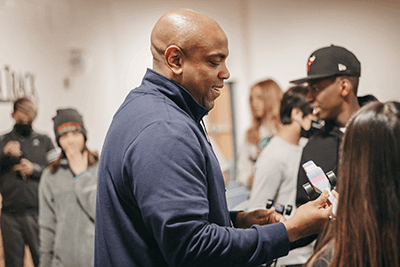May 26, 2022
 from Lamar Shingles, Director of Equity and Belonging
from Lamar Shingles, Director of Equity and Belonging
One Thursday per month you will see a guest Head’s Message from a member of the Institutional Advancement Team. We hope these additional perspectives will help you catch a glimpse inside the inner-workings of your school.
As the sun begins to set on my first year at MPA, I have become increasingly reflective of my experience over the past 10 months—a cerebral space where many educators find themselves to be on the eve of commencement and summer break. What can I say, introspection is my jam! I have learned so much about education that I didn’t already know and engaged with amazing people across this community. What has really stood out for me and made a profound impact on my experience thus far is the time I’ve spent with students in the Middle and Upper School BIPOC affinity groups.
When I think back on my own experience as one of only a few black students in my class, every day was a reminder that I was different from my peers. I recall my mom’s reaction when I begged her to let me bleach my hair blonde. I remember the feeling I got in the pit of my stomach when racial epithets were read aloud in class text—the bewildered eyes that descended upon me throughout the classroom as my peers searched for my response. Mostly, I remember an overwhelming feeling of loneliness. As a child, I didn’t have the terminology, adolescent social development models, or supportive resources to help define how I felt—but knew, I just wanted to fit in.
So what are affinity groups?
In a recent conversation with two of our Lower School teachers, Ms. Santiago and Mr. Moore, I thought they summed it up very well:
“Affinity groups provide a safe and secure space for students to explore and develop their sense of identity in a facilitated environment where they do not feel isolated, but connected. This enables them to grow into strong advocates for themselves and others”.
Affinity groups provide an opportunity for students to speak from the “I” perspective, at a critical time when they are formulating who they are among their peers and the broader community. These spaces can serve as a powerful mechanism for self and group affirmation by reducing feelings of isolation and discomfort that many students face—and instead, encourages students to be confident and proud of who they are.
At MPA, there are currently three BIPOC affinity groups—fifth and sixth, seventh and eighth, and Upper School—that were established in 2021 out of a request from students of color who wanted a safe space to gather and reflect on their experiences, without feelings of marginalization. More than 30 students have consistently attended facilitated group meetings and engaged in dialogue across a broad range of topics throughout the year.
It has been a privilege to see firsthand how affinity space can positively influence the sense of belonging for students at MPA, while also demonstrating the value of our commitment to becoming more inclusive as a community. Looking back on my own journey, I can’t help but to wonder, what may have been different if I had the benefit of a safe space that celebrated the most authentic version of me? Looking ahead, I am incredibly optimistic that we will continue to create opportunities that ensure all are students will never have to ask that question.